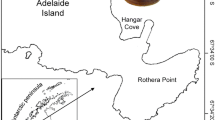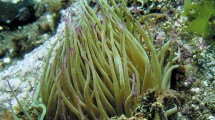Abstract
The features of the reproductive biology such as morphology of gametes, larval morphology, larval development and development of gametes of Marenzelleria viridis Type II from the Baltic were summarized. Further reproductive features of Baltic Sea populations are given and the purpose of the review is to account for the successful immigration of M. viridis into the oligohaline areas of the Baltic considered against a background of such variables as population density and structure, salinity, temperature, food availability, oxygen and sulphide levels. Gametogenesis started in spring. Fecundity of animals depended on salinity, temperature, age and size of worms. Mature oocytes contained large cortical alveoli not yet known for polychaetes. Animals spawned in autumn in all years of investigation. The pelagic larvae of M. viridis Type II were found mainly from September to November. Larval development depended on water temperature and lasted about 4 to 12 weeks. Successful larval development from egg to juvenile was not possible below salinities of 5‰, but colonization of oligohaline regions took place by larvae with more than 4 setigers or by swimming juveniles. Reproductive features of M. viridis Type II from the Baltic were compared and discussed with the results of M. viridis Type I populations from the North Sea and North America. The two M. viridis types reproduced at different time, M. viridis Type I reproduced in spring and M. viridis Type II in autumn. Both types showed also differences in larval development, gametal development and sex ratio of mature worms.
Similar content being viewed by others
References
Arndt E-A (1960) Über die Rindenvakuolen der Teleosteeroocyten. Z Zellforsch 51: 209–224
Arndt E-A (1988) Zusammenfassende Ergebnisse von Untersuchungen am Macrozoobenthos der Darß-Zingster Boddenkette von 1969–1987. Wissenschaftliche Zeitung Wilhelm-Pieck Universität Rostock 37(5): 6–12
Arndt E-A (1989) Ecological, physiological and historical aspects of brackish water fauna distribution. In: Ryland JS and Tyler PA (eds), Reproduction, Genetics and Distribution of Marine Organisms, 23rd European Marine Biology Symposium Olsen and Olsen, Fredensborg, Denmark, pp. 327–338
Atkins SM, Jones AM and Garwood PR (1987) The ecology and reproductive cycle of a population of Marenzelleria viridis (Annelida: Polychaeta: Spionidae) in the Tay Estuary. Proc Roy Soc Edinburgh 92(3–4): 311–322
Bastrop R, Röhner M, Sturmbauer C and Jürss K (1997) Where did Marenzelleria spp. (Polychaeta: Spionidae) in Europe come from? Aquat Ecol 31: 119–136
Bochert A, Richard D and Bochert R (1997) Marenzelleria cf. viridis and the sulphide regime. Aquat Ecol 31: 223–231
Bochert R (1996a) An electron microscopic study of spermatogenesis in Marenzelleria viridis (Verrill, 1873) (Polychaeta; Spionidae). Acta Zool (Stockholm) 77(3): 191–199
Bochert R (1996b) An electron microscopic study of oogenesis in Marenzelleria viridis (Verrill, 1873) (Polychaeta; Spionidae) with special reference to large cortical alveoli. Inv Rep Devel 29(1): 57–69
Bochert R (1996c) Untersuchungen zur Reproduktionsbiologie von Marenzelleria viridis (Polychaeta, Spionidae) in einem flachen Küstengewässer der südlichen Ostsee. Ph.D-thesis, University of Rostock, Shaker Verlag, Aachen
Bochert R and Bick A (1995) Reproduction and larval development of Marenzelleria viridis (Verrill, 1873) (Polychaeta: Spionidae). Mar Biol 123(4): 763–773
Bochert R, Zettler ML and Bick A (1994) Untersuchungen zur räumlichen Verteilung der Larven von Marenzelleria viridis (Polychaeta; Spionidae) in einem flachen Küstengewässer der Ostsee. Rostocker Meeresbiol Beitr 2: 227–240
Bochert R, Fritzsche D and Burckhardt R (1996a) Influence of salinity and temperature on growth and survival of the planktonic larvae of Marenzelleria viridis (Polychaeta, Spionidae). J Plankton Res 18(7): 1239–1251
Bochert R, Zettler ML and Bochert A (1996b) Temporal and spatial variation in the reproductive condition, larval occurrence and recruitment in an estuarine population of Marenzelleria viridis (Polychaeta: Spionidae). Ophelia 45(2): 127–142
Bochert R, Bick A, Zettler ML and Arndt E-A (1997) Marenzelleria viridis (Verrill, 1873) (Polychaeta: Spionidae), an invader in the benthic community in Baltic coastal inlets. Investigations of the reproduction. In: Andrusaitis A (ed.), Proceedings of the 13 Baltic Marine Biologists-Symposium, Jũrmala, Latvia, 1993: 131–139
Boesch DF, Wass ML and Virnstein RW (1976) The dynamics of estuarine benthic communities. In: Wiley M (ed.), Estuarine Processes, Vol. I: Uses Stress, and Adaptations to the estuary, Academic Press, New York, pp. 177–196
Burckhardt R, Schumann R and Bochert R (1997) Feeding biology of the pelagic larvae of Marenzelleria cf, viridis (Polychaeta: Spionidae) from the Baltic Sea. Aqat Ecol 31: 149–162
Clark WH and Lynn JW (1977) A Mg++ dependent cortical reaction in the eggs of penaid shrimp. J Exp Zool 200(1): 177–183
Colwin AL and Colwin LH (1961a) Fine structure of the spermatozoon of Hydroides hexagonus (Annelida), with special reference to the acrosomal region. J Biophys Biochem Cytol 10: 211–230
Colwin LH and Colwin AL (1961b) Changes in the spermatozoon during fertilization in Hydroides hexagonus (Annelida). I. Passage of the acrosomal region through the vitelline membrane. J Biophys Biochem Cytol 10: 231–254
Dauer DM, Ewing RM, Touretelotte GH and Barker HR Jr. (1980) Nocturnal swimming of Scolecolepides viridis (Polychaeta; Spionidae). Estuaries 3: 148–149
Dauer DM, Maybury CA and Ewing RM (1981) Feeding behaviour and general ecology of several spionid polychaetes from the Chesapeake Bay. J Exp Mar Biol Ecol 54(1): 21–38
Dauer DM, Ewing RM, Sourbeer JW, Harlan WT and Stokes TL (1982) Nocturnal movements of the macrobenthos of the Lafayette River, Virginia. Int Rev Ges Hydrobiol. 67(6): 761–775
Day JH and Wilson DP (1934) On the relation of the substratum to the metamorphosis of Scolecolepis fuligonosa (Claparede). J Mar Biol Ass UK 19(2): 655–662
Eckelbarger KJ (1988) Oogenesis and female gametes. In: Westheide W and Hermans CO (eds.), The Ultrastructure of Polychacta. Microfauna Marina Band 4, Gustav Fischer Verlag Stuttgart, pp. 281–307
Eckelbarger KJ and Chia F-S (1978) Morphogenesis of larval cuticle in the polychaete Phragmatopoma lapidosa. Cell Tissue Res 186: 187–201
Essink K and Kleef HL (1993) Distribution and life cycle of the North American Spionid Polychaete Marenzelleria viridis (Verrill, 1873) in the Ems Estuary. Neth J Aquat Ecol 27(2–4): 237–246
Franzén, Å (1956) On spermiogenesis, morphology of the spermatozoon and biology of fertilization among invertebrates. Zool Bidrag Uppsala 31: 355–482
Fritzsche D (1995) Leistungsanalytische und resistenzökologische Untersuchungen zur Emanzipation des Polychaeten Marenzelleria viridis (Verrill 1873) gegenüber den Faktoren Salinität und Sauerstoffpartialdruck. Inaugural-Dissertation, Universität Rostock
George JD (1966) Reproduction and early development of the spionid polychaete, Scolecolepides viridis (Verrill). Biol Bull 130(1): 76–93
Graebner I and Kryvi H (1973a) The spermiogenesis and mature sperm of Sabella penicillum (Polychaeta). An electron microscopical investigation. Norwegian J Zool 21: 211–226
Graebner I and Kryvi H (1973b) Zur Feinstruktur des Spermiums von Sabella penicillum. Mikroskopie 29: 331–333
Grieshaber MK, Hardewig I, Kreutzer U and Pörtner H-O (1994) Physiological and metabolic responses to hypoxia in invertebrates. Rev Physiol Biochem Pharmacol 125: 43–147
Guraya SS (1967) The origin and nature of cortical vacuoles in the amphioxus egg. Z Zellforsch 79: 326–331
Guraya SS (1982) Recent progress in the structure, origin, composition and function of cortical granules in animal egg. Int Rev Cytol 78: 237–360
Hannerz L (1956) Larval development of the polychaete families Spionidae Sars, Disomidae Mesnil and Poecilochaetidae N. Fam. in the Gullmar Fjord (Sweden). Zool Bidr Uppsala 31: 1–204
Holland AF, Mountford NK, Hiegel MH, Kaumeyer KR and Mihursky JA (1980) Influence of predation on infauna abundance in Upper Chesapeake Bay, USA. Mar Biol 57: 221–235
Jamieson BGM and Rouse GW (1989) The spermatozoa of the polychaeta (Annelida): An ultrastructural review. Biol Rev 64: 93–157
Jordan RA and Sutton CE (1984) Oligohaline benthic invertebrate communities at two Chesapeake Bay power plants. Estuaries 7(3): 192–212
Lodge DM (1993) Species invasions and deletions: community effects and responses to climate and habitate change. In: Karieva P, Kingsolver J and Huey R (eds.), Biotic interactions and global change. Sinauer, Sunderland, Massachusetts, pp. 367–387
Plate S (1992) Untersuchungen zum zeitlichen Auftreten, zur Abundanz und Entwicklung meroplanktischer Polychaetenlarven im Gebiet Helgoländer Reede. Ordnungen Orbiniida, Spionida, Capitellida. Dissertation Fakultät Biologie an der Ruhr-Universität Bochum
Rice SA (1981) Spermatogenesis and sperm ultrastructure in three species of Polydora and in Streblospio benedicit (Polychaeta: Spionidae). Zoomorphol 97: 1–16
Schlungbaum G and Baudler H (1996) Gewaesserguetebericht für die Darss-Zingster Boddenkette 1994/1995 mit Vergleichen zur Langzeitenentwicklung. Ministerium fuer Bau, Landesentwicklung und Umwelt des Landes Mecklenburg-Vorpommern
Schöttler U, Surholt B and Zebe B (1984) Anaerobic metabolism in Arenicola marina and Nereis diversicolor during low tide. Mar Biol 81: 69–73
Schneider A (1996) Metabolic rate of the brackish water polychaete Marenzelleria viridis under reducing conditions. Thermochimica Acta 271: 31–40
Schroeder PC and Hermans CD (1975) Annelida: Polychaeta. In: Giese AC and Pearse JS (eds.), Reproduction of marine invertebrates, Academic Press, London, pp. 1–213
Simon JL (1968) Occurrence of pelagic larvae in Spio setosa Verrill, 1873 (Polychaeta, Spionidae). Biol Bull Woods Hole 134: 503–515
Whitlatch RB (1977) Seasonal changes in the community structure of the macrobenthos inhabiting the intertidal sand and mud flats of Barnstable Harbor, Massachusetts. Biol Bull Woods Hole 152: 275–294
Wilson WH (1991) Sexual reproductive modes in polychaetes: Classification and diversity. Bull Mar Sci 48(2): 500–516
Winkler H and Debus L (1997) Is the polychaete Marenzelleria viridis and important food item for fish? In: Andrusaitis A (ed.), Proceedings of the 13 Baltic Marine Biologists Symposium, Jũrmala, Lativia, 1993: 147–151
Zettler ML (1996) Successful establishment of the spionid polychaete, Marenzelleria viridis (Verrill, 1873), in the Darss-Zingst estuary (southern Baltic) and its influenceon the indigenous macrozoobenthos. Arch Fish Mar Res 43(3): 273–284
Zettler ML, Bochert R and Bick A (1994) Röhrenbau und Vertikalverteilung von Marenzelleria viridis (Polychaeta: Spionidae) in einem inneren Küstengewässer der südlichen Ostsee. Rostock Meeresbiol Beitr 2: 215–225
Zettler ML, Bick A and Bochert R (1995) Distribution and population dynamic of Marenzelleria viridis (Polychaeta: Spionidae) in a coastal water of the southern Baltic. Arch Fish Mar Res 42(3): 209–224
Author information
Authors and Affiliations
Rights and permissions
About this article
Cite this article
Bochert, R. Marenzelleria viridis (Polychaeta: Spionidae): a review of its reproduction. Aquatic Ecology 31, 163–175 (1997). https://doi.org/10.1023/A:1009951404343
Issue Date:
DOI: https://doi.org/10.1023/A:1009951404343




